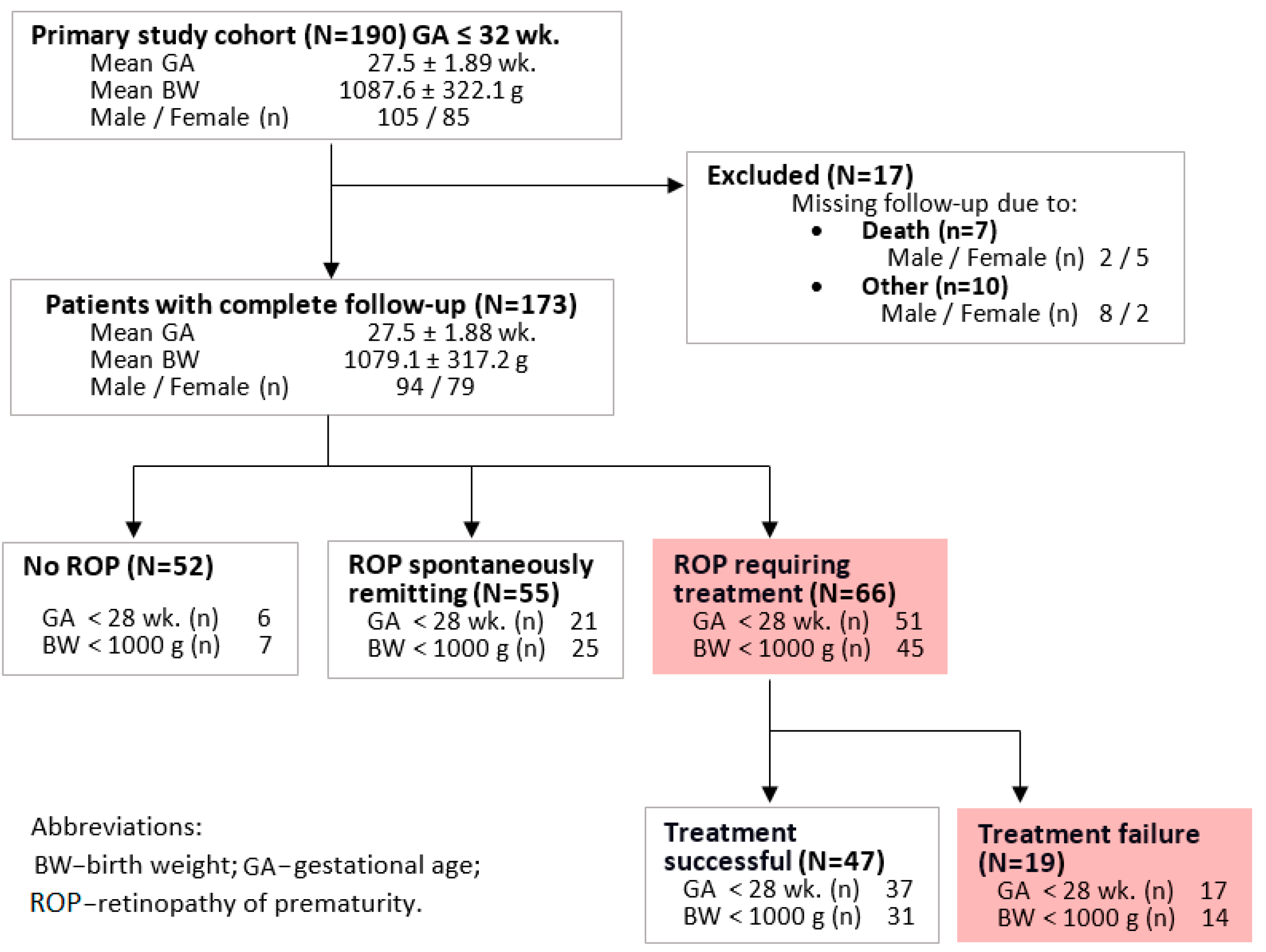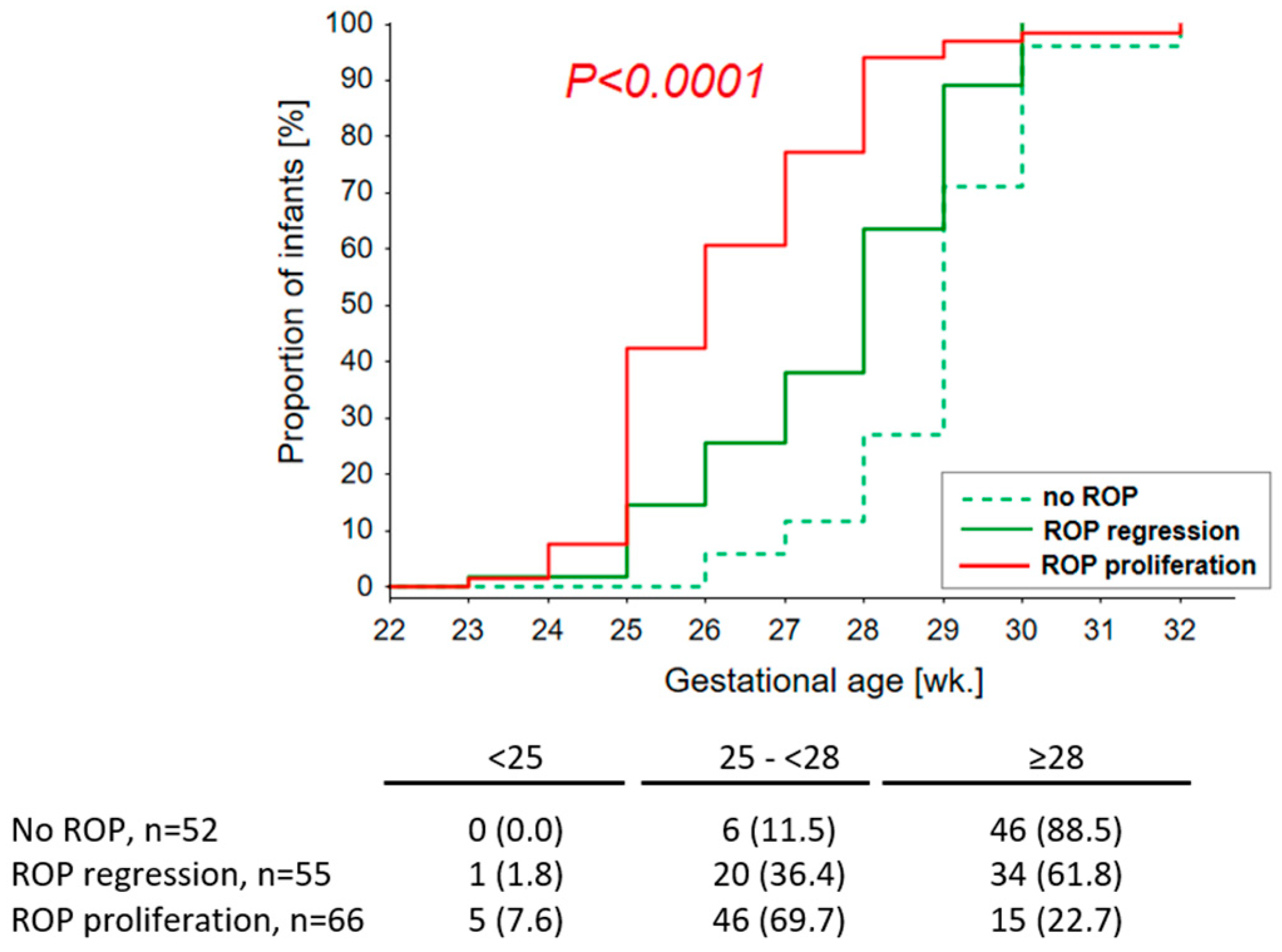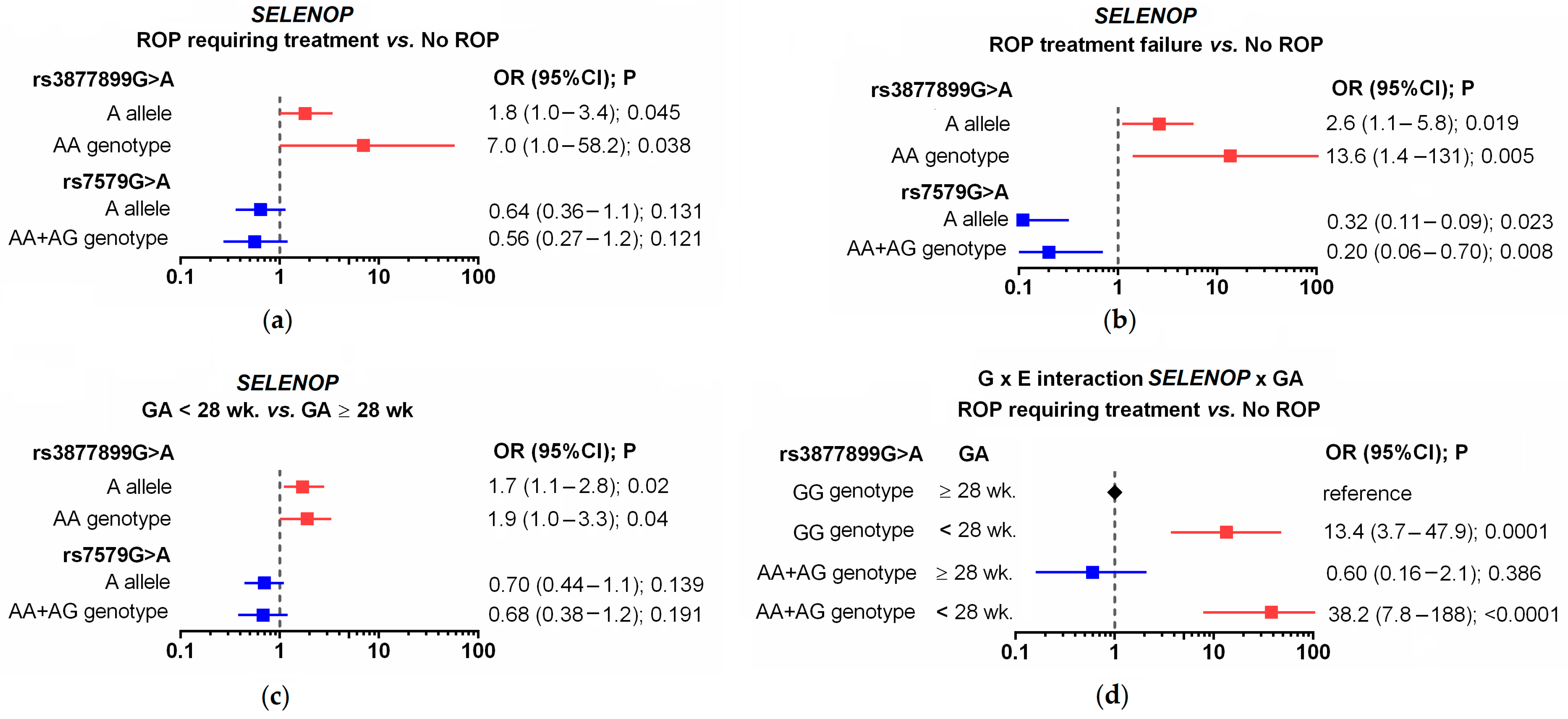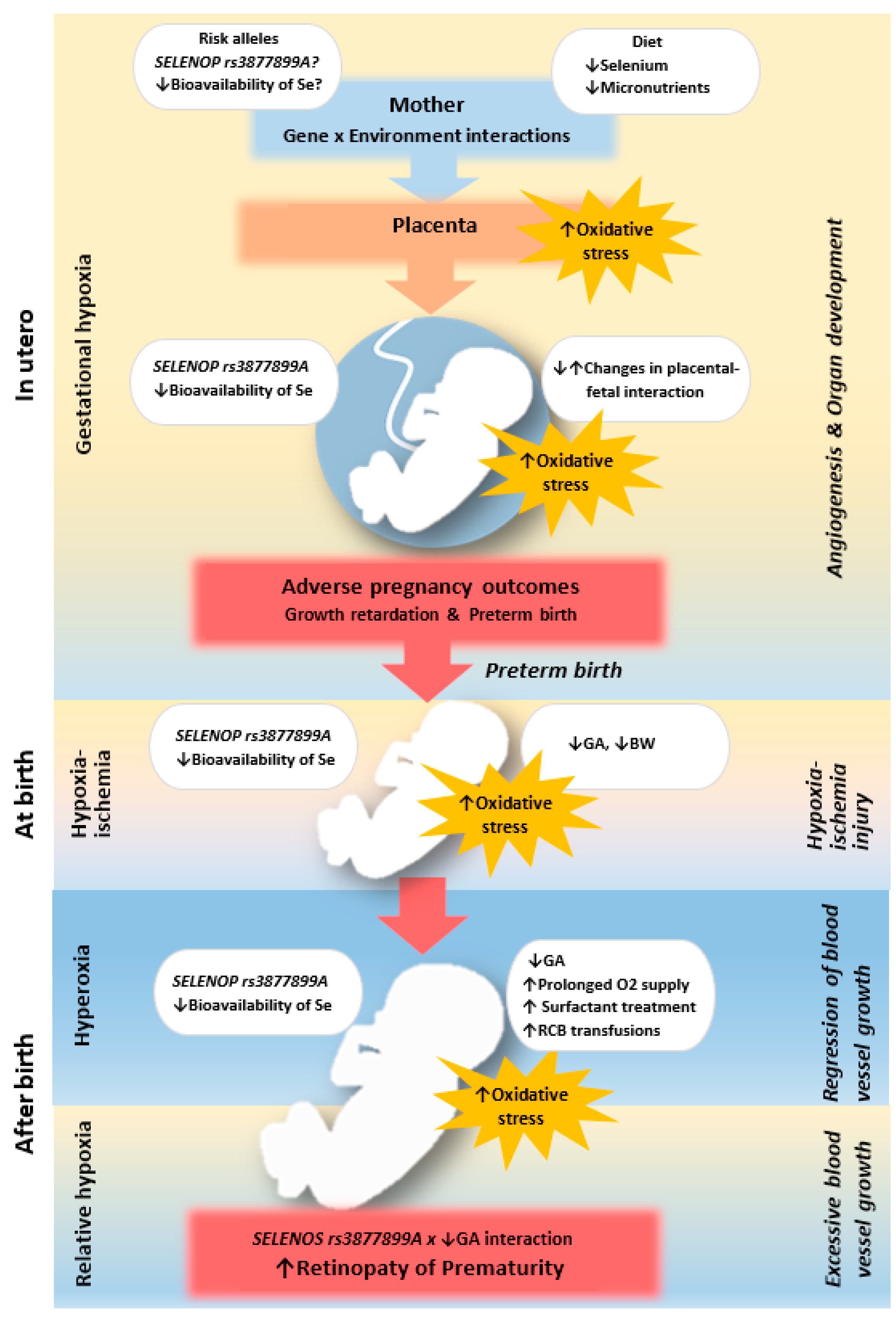SELENOP rs3877899 Variant Affects the Risk of Developing Advanced Stages of Retinopathy of Prematurity (ROP)
Abstract
1. Introduction
2. Results
2.1. Clinical Risk Factors of ROP Development and Unsuccessful Treatment
2.2. Polymorphisms in Selenoprotein Genes and the Incidence, Severity, and Treatment of ROP
2.3. Polymorphisms in Selenoprotein Genes and the Incidence of Other Complications of Prematurity
2.4. Gene-Environment Interaction between the SELENOP Genotype and ELGA
2.5. Independent Predictors of the Occurrence and Progression of ROP
3. Discussion
4. Materials and Methods
4.1. Study Population
4.2. Clinical Features and Outcomes
4.3. Genotyping
4.4. Statistical Analysis
Supplementary Materials
Author Contributions
Funding
Institutional Review Board Statement
Informed Consent Statement
Data Availability Statement
Acknowledgments
Conflicts of Interest
References
- Kassabian, S.; Fewer, S.; Yamey, G.; Brindis, C.D. Building a global policy agenda to prioritize preterm birth: A qualitative analysis on factors shaping global health policymaking. Gates Open. Res. 2020, 4, 65. [Google Scholar] [CrossRef]
- Ozsurekci, Y.; Aykac, K. Oxidative Stress Related Diseases in Newborns. Oxid. Med. Cell. Longev. 2016, 2016, 2768365. [Google Scholar] [CrossRef]
- Lembo, C.; Buonocore, G.; Perrone, S. Oxidative Stress in Preterm Newborns. Antioxidants 2021, 10, 1672. [Google Scholar] [CrossRef]
- Curran, J.E.; Jowett, J.B.; Elliott, K.S.; Gao, Y.; Gluschenko, K.; Wang, J.; Abel Azim, D.M.; Cai, G.; Mahaney, M.C.; Comuzzie, A.G.; et al. Genetic variation in selenoprotein S influences inflammatory response. Nat. Genet. 2005, 37, 1234–1241. [Google Scholar] [CrossRef]
- Donadio, J.L.S.; Duarte, G.B.S.; Borel, P.; Cozzolino, S.M.F.; Rogero, M.M. The influence of nutrigenetics on biomarkers of selenium nutritional status. Nutr. Rev. 2021, 79, 1259–1273. [Google Scholar] [CrossRef]
- Tindell, R.; Tipple, T. Selenium: Implications for outcomes in extremely preterm infants. J. Perinatol. 2018, 38, 197–202. [Google Scholar] [CrossRef] [PubMed]
- Poggi, C.; Giusti, B.; Vestri, A.; Pasquini, E.; Abbate, R.; Dani, C. Genetic polymorphisms of antioxidant enzymes in preterm infants. J. Matern. Fetal Neonatal Med. 2012, 25 (Suppl. 4), 131–134. [Google Scholar] [CrossRef] [PubMed]
- Thurnham, D.I.; Northrop-Clewes, C.A. Inflammation and biomarkers of micronutrient status. Curr. Opin. Clin. Nutr. Metab. Care 2016, 19, 458–463. [Google Scholar] [CrossRef]
- Makhoul, I.R.; Sammour, R.N.; Diamond, E.; Shohat, I.; Tamir, A.; Shamir, R. Selenium concentrations in maternal and umbilical cord blood at 24–42 weeks of gestation: Basis for optimization of selenium supplementation to premature infants. Clin. Nutr. 2004, 23, 373–381. [Google Scholar] [CrossRef]
- Yang, H.; Ding, Y.; Chen, L. Effect of trace elements on retinopathy of prematurity. J. Huazhong Univ. Sci. Technol. Med. Sci. 2007, 27, 590–592. [Google Scholar] [CrossRef] [PubMed]
- Tarhonska, K.; Raimondi, S.; Specchia, C.; Wieczorek, E.; Reszka, E.; Krol, M.B.; Gromadzinska, J.; Wasowicz, W.; Socha, K.; Borawska, M.H.; et al. Association of allelic combinations in selenoprotein and redox related genes with markers of lipid metabolism and oxidative stress—Multimarkers analysis in a cross-sectional study. J. Trace Elem. Med. Biol. 2022, 69, 126873. [Google Scholar] [CrossRef]
- Schoenmakers, E.; Chatterjee, K. Human Genetic Disorders Resulting in Systemic Selenoprotein Deficiency. Int. J. Mol. Sci. 2021, 22, 12927. [Google Scholar] [CrossRef]
- Kim, S.J.; Port, A.D.; Swan, R.; Campbell, J.P.; Chan, R.V.P.; Chiang, M.F. Retinopathy of prematurity: A review of risk factors and their clinical significance. Surv. Ophthalmol. 2018, 63, 618–637. [Google Scholar] [CrossRef]
- Demir, S.; Yücel, Ö.E.; Niyaz, L.; Karakuş, G.; Arıtürk, N. Incidence of retinopathy of prematurity in the middle Black Sea region of Turkey over a 10-year period. J. Aapos 2015, 19, 12–15. [Google Scholar] [CrossRef]
- Yucel, O.E.; Eraydin, B.; Niyaz, L.; Terzi, O. Incidence and risk factors for retinopathy of prematurity in premature, extremely low birth weight and extremely low gestational age infants. BMC Ophthalmol. 2022, 22, 367. [Google Scholar] [CrossRef]
- Hong, E.H.; Shin, Y.U.; Bae, G.H.; Choi, Y.J.; Ahn, S.J.; Sobrin, L.; Hong, R.; Kim, I.; Cho, H. Nationwide incidence and treatment pattern of retinopathy of prematurity in South Korea using the 2007–2018 national health insurance claims data. Sci. Rep. 2021, 11, 1451. [Google Scholar] [CrossRef] [PubMed]
- Swan, R.; Kim, S.J.; Campbell, J.P.; Paul Chan, R.V.; Sonmez, K.; Taylor, K.D.; Li, X.; Chen, Y.I.; Rotter, J.I.; Simmons, C.; et al. The genetics of retinopathy of prematurity: A model for neovascular retinal disease. Ophthalmol. Retina 2018, 2, 949–962. [Google Scholar] [CrossRef] [PubMed]
- Kim, S.J.; Sonmez, K.; Swan, R.; Campbell, J.P.; Ostmo, S.; Chan, R.V.P.; Nagiel, A.; Drenser, K.A.; Berrocal, A.M.; Horowitz, J.D.; et al. Identification of candidate genes and pathways in retinopathy of prematurity by whole exome sequencing of preterm infants enriched in phenotypic extremes. Sci. Rep. 2021, 11, 4966. [Google Scholar] [CrossRef] [PubMed]
- Tao, T.; Meng, X.; Xu, N.; Li, J.; Cheng, Y.; Chen, Y.; Huang, L. Ocular phenotype and genetical analysis in patients with retinopathy of prematurity. BMC Ophthalmol. 2022, 22, 22. [Google Scholar] [CrossRef]
- Bermano, G.; Pagmantidis, V.; Holloway, N.; Kadri, S.; Mowat, N.A.; Shiel, R.S.; Arthur, J.R.; Mathers, J.C.; Daly, A.K.; Broom, J.; et al. Evidence that a polymorphism within the 3’UTR of glutathione peroxidase 4 is functional and is associated with susceptibility to colorectal cancer. Genes. Nutr. 2007, 2, 225–232. [Google Scholar] [CrossRef]
- Du, X.H.; Dai, X.X.; Xia Song, R.; Zou, X.Z.; Yan Sun, W.; Mo, X.Y.; Lu Bai, G.; Xiong, Y.M. SNP and mRNA expression for glutathione peroxidase 4 in Kashin-Beck disease. Br. J. Nutr. 2012, 107, 164–169. [Google Scholar] [CrossRef]
- Li, J.; Zhu, Y.; Zhou, Y.; Jiang, H.; Chen, Z.; Lu, B.; Shen, X. The SELS rs34713741 Polymorphism Is Associated with Susceptibility to Colorectal Cancer and Gastric Cancer: A Meta-Analysis. Genet. Test. Mol. Biomark. 2020, 24, 835–844. [Google Scholar] [CrossRef] [PubMed]
- Meplan, C.; Hughes, D.J.; Pardini, B.; Naccarati, A.; Soucek, P.; Vodickova, L.; Hlavata, I.; Vrana, D.; Vodicka, P.; Hesketh, J.E. Genetic variants in selenoprotein genes increase risk of colorectal cancer. Carcinogenesis 2010, 31, 1074–1079. [Google Scholar] [CrossRef] [PubMed]
- Strauss, E.; Oszkinis, G.; Staniszewski, R. SEPP1 gene variants and abdominal aortic aneurysm: Gene association in relation to metabolic risk factors and peripheral arterial disease coexistence. Sci. Rep. 2014, 4, 7061. [Google Scholar] [CrossRef] [PubMed]
- Sutherland, A.; Kim, D.H.; Relton, C.; Ahn, Y.O.; Hesketh, J. Polymorphisms in the selenoprotein S and 15-kDa selenoprotein genes are associated with altered susceptibility to colorectal cancer. Genes. Nutr. 2010, 5, 215–223. [Google Scholar] [CrossRef] [PubMed]
- Mostert, V.; Lombeck, I.; Abel, J. A novel method for the purification of selenoprotein P from human plasma. Arch. Biochem. Biophys. 1998, 357, 326–330. [Google Scholar] [CrossRef]
- Meplan, C.; Nicol, F.; Burtle, B.T.; Crosley, L.K.; Arthur, J.R.; Mathers, J.C.; Hesketh, J.E. Relative abundance of selenoprotein P isoforms in human plasma depends on genotype, se intake, and cancer status. Antioxid. Redox Signal. 2009, 11, 2631–2640. [Google Scholar] [CrossRef]
- Méplan, C.; Crosley, L.K.; Nicol, F.; Beckett, G.J.; Howie, A.F.; Hill, K.E.; Horgan, G.; Mathers, J.C.; Arthur, J.R.; Hesketh, J.E. Genetic polymorphisms in the human selenoprotein P gene determine the response of selenoprotein markers to selenium supplementation in a gender-specific manner (the SELGEN study). FASEB J. 2007, 21, 3063–3074. [Google Scholar] [CrossRef]
- Mao, J.; Vanderlelie, J.J.; Perkins, A.V.; Redman, C.W.; Ahmadi, K.R.; Rayman, M.P. Genetic polymorphisms that affect selenium status and response to selenium supplementation in United Kingdom pregnant women. Am. J. Clin. Nutr. 2016, 103, 100–106. [Google Scholar] [CrossRef]
- Kurokawa, S.; Bellinger, F.P.; Hill, K.E.; Burk, R.F.; Berry, M.J. Isoform-specific binding of selenoprotein P to the β-propeller domain of apolipoprotein E receptor 2 mediates selenium supply. J. Biol. Chem. 2014, 289, 9195–9207. [Google Scholar] [CrossRef]
- Giusti, B.; Vestrini, A.; Poggi, C.; Magi, A.; Pasquini, E.; Abbate, R.; Dani, C. Genetic polymorphisms of antioxidant enzymes as risk factors for oxidative stress-associated complications in preterm infants. Free. Radic. Res. 2012, 46, 1130–1139. [Google Scholar] [CrossRef]
- Villette, S.; Kyle, J.A.; Brown, K.M.; Pickard, K.; Milne, J.S.; Nicol, F.; Arthur, J.R.; Hesketh, J.E. A novel single nucleotide polymorphism in the 3’ untranslated region of human glutathione peroxidase 4 influences lipoxygenase metabolism. Blood Cells Mol. Dis. 2002, 29, 174–178. [Google Scholar] [CrossRef]
- Foster, C.B.; Aswath, K.; Chanock, S.J.; McKay, H.F.; Peters, U. Polymorphism analysis of six selenoprotein genes: Support for a selective sweep at the glutathione peroxidase 1 locus (3p21) in Asian populations. BMC Genet. 2006, 7, 56. [Google Scholar] [CrossRef] [PubMed]
- Beharier, O.; Tyurin, V.A.; Goff, J.P.; Guerrero-Santoro, J.; Kajiwara, K.; Chu, T.; Tyurina, Y.Y.; St Croix, C.M.; Wallace, C.T.; Parry, S.; et al. PLA2G6 guards placental trophoblasts against ferroptotic injury. Proc. Natl. Acad. Sci. USA 2020, 117, 27319–27328. [Google Scholar] [CrossRef]
- Duntas, L.H. Selenium and at-risk pregnancy: Challenges and controversies. Thyroid. Res. 2020, 13, 16. [Google Scholar] [CrossRef]
- Lewandowska, M.; Więckowska, B.; Sajdak, S.; Lubiński, J. First Trimester Microelements and their Relationships with Pregnancy Outcomes and Complications. Nutrients 2020, 12, 1108. [Google Scholar] [CrossRef] [PubMed]
- Humberg, A.; Fortmann, I.; Siller, B.; Kopp, M.V.; Herting, E.; Göpel, W.; Härtel, C. Preterm birth and sustained inflammation: Consequences for the neonate. Semin. Immunopathol. 2020, 42, 451–468. [Google Scholar] [CrossRef]
- Boskabadi, H.; Marefat, M.; Maamouri, G.; Abrishami, M.; Abrishami, M.; Shoeibi, N.; Sanjari, M.S.; Mobarhan, M.G.; Shojaei, S.R.H.; Tavallaei, S.; et al. Evaluation of pro-oxidant antioxidant balance in retinopathy of prematurity. Eye 2022, 36, 148–152. [Google Scholar] [CrossRef] [PubMed]
- Darlow, B.A.; Austin, N.C. Selenium supplementation to prevent short-term morbidity in preterm neonates. Cochrane Database Syst. Rev. 2003, 2003, Cd003312. [Google Scholar] [CrossRef] [PubMed]
- Terrin, G.; Berni Canani, R.; Passariello, A.; Messina, F.; Conti, M.G.; Caoci, S.; Smaldore, A.; Bertino, E.; De Curtis, M. Zinc supplementation reduces morbidity and mortality in very-low-birth-weight preterm neonates: A hospital-based randomized, placebo-controlled trial in an industrialized country. Am. J. Clin. Nutr. 2013, 98, 1468–1474. [Google Scholar] [CrossRef]
- Ishikura, K.; Misu, H.; Kumazaki, M.; Takayama, H.; Matsuzawa-Nagata, N.; Tajima, N.; Chikamoto, K.; Lan, F.; Ando, H.; Ota, T.; et al. Selenoprotein P as a diabetes-associated hepatokine that impairs angiogenesis by inducing VEGF resistance in vascular endothelial cells. Diabetologia 2014, 57, 1968–1976. [Google Scholar] [CrossRef] [PubMed]
- Kosik, K.; Szpecht, D.; Al-Saad, S.R.; Karbowski, L.M.; Kurzawińska, G.; Szymankiewicz, M.; Drews, K.; Wolski, H.; Seremak-Mrozikiewicz, A. Single nucleotide vitamin D receptor polymorphisms (FokI, BsmI, ApaI, and TaqI) in the pathogenesis of prematurity complications. Sci. Rep. 2020, 10, 21098. [Google Scholar] [CrossRef] [PubMed]
- Chmielarz-Czarnocińska, A.; Pawlak, M.; Szpecht, D.; Choręziak, A.; Szymankiewicz-Bręborowicz, M.; Gotz-Więckowska, A. Management of retinopathy of prematurity (ROP) in a Polish cohort of infants. Sci. Rep. 2021, 11, 4522. [Google Scholar] [CrossRef] [PubMed]
- Botto, L.D.; Khoury, M.J. Commentary: Facing the challenge of gene-environment interaction: The two-by-four table and beyond. Am. J. Epidemiol. 2001, 153, 1016–1020. [Google Scholar] [CrossRef] [PubMed]




| Parameter | Incidence and Outcome of ROP | ROP Requiring Treatment | |||||
|---|---|---|---|---|---|---|---|
| I No ROP N = 52 | II ROP Not Requiring Treatment N = 55 | III ROP Requiring TreatmentN = 66 | β, pfor trend I/II/III | IIIa ROP Treated Successfully N = 47 | IIIb ROP Treated Unsuccessfully N = 19 | p IIIa vs. IIIb | |
| Gestational age [wk.] | |||||||
| Mean (SD) | 28.9 (1.2) | 27.7 (1.7) | 26.2 (1.6) | −0.591, <0.0001 | 26.4 (1.8) | 25.9 (1.6) | 0.375 |
| Range | 26–32 | 23–30 | 23–34 | 23–32 | 24–29 | ||
| Body mass [g] | |||||||
| Mean (SD) | 1317.7 (326.6) | 1044.3 (266.9) | 920.2 (226.1) | −0.509, <0.0001 | 943.4 (242.9) | 862.6 (170.1) | 0.191 |
| Range | 640–2080 | 490–1600 | 500–1700 | 500–1700 | 570–1160 | ||
| Intrauterine hypotrophy; n (%) | 3 (7.7) | 7 (12.7) | 2 (3.1) | −0.051, 0.504 | 2 (4.4) | 0 (0.0) | 0.358 |
| Male sex; n (%) | 26 (50.0) | 31 (56.4) | 37 (57.8) | 0.063, 0.412 | 28 (62.2) | 9 (47.4) | 0.279 |
| Apgar 1; Median (Q1; Q3) | 6 (4; 8) | 4 (2; 6) | 3 (3; 6) | −0.323, <0.0001 | 3 (1; 6) | 3.5 (1; 6) | 0.769 |
| Apgar 5; Median (Q1; Q3) | 7 (7; 8) | 7 (6; 8) | 7 (6; 7) | −0.267, <0.001 | 7 (6; 7) | 7 (5; 7) | 0.960 |
| No. of RBC transfusions; Mean (SD) | 1.4 (1.12) | 2.8 (2.2) | 5.5 (2.8) | 0.554, <0.0001 | 4.5 (2.0) | 8.0 (3.6) | 0.026 |
| Risk factors at birth | |||||||
| Ruptured fetal bladder; n (%) | 19 (36.5) | 18 (32.7) | 22 (34.9) | −0.012, 0.873 | 14 (31.8) | 8 (42.1) | 0.440 |
| Ruptured fetal bladder period [d]; Mean (SD) | 3.6 (6.4) | 4.6 (10.9) | 5.1 (14.0) | 0.058, 0.449 | 6.7 (16.4) | 1.6 (2.6) | 0.192 |
| Delivery by caesarean section; n (%) | 29 (55.8) | 27 (49.1) | 29 (45.3) | −0.085, 0.269 | 22 (48.9) | 7 (36.8) | 0.384 |
| Parameters related to respiratory failure | |||||||
| Surfactant treatment; n (%) | 17 (23.7) | 27 (41.8) | 46 (71.9) | 0.327, 0.0005 | 33 (73.3) | 13 (68.4) | 0.695 |
| Resuscitation; n (%) | 34 (65.4) | 49 (89.1) | 62 (96.9) | 0.354, 0.0001 | 43 (95.6) | 19 (100.0) | 0.358 |
| Mechanical ventilation; n (%) | 32 (61.5) | 43 (78.2) | 65 (98.5) | 0.388, <0.0001 | 46 (97.9) | 19 (100.0) | 0.529 |
| Mechanical ventilation period [d]; Mean (SD) | 6.1 (9.0) | 18.8 (19.2) | 33.7 (20.9) | 0.548, <0.0001 | 33.9 (21.5) | 33.3 (19.7) | 0.908 |
| Complications of prematurity; n (%) | |||||||
| NEC | 6 (11.5) | 17 (31.5) | 24 (37.5) | 0.234, 0.002 | 16 (35.6) | 8 (42.1) | 0.628 |
| BPD | 7 (13.5) | 27 (49.1) | 46 (71.9) | 0.477, <0.0001 | 34 (75.6) | 12 (63.2) | 0.321 |
| PDA | 8 (15.4) | 21 (38.2) | 21 (32.8) | 0.149, 0.052 | 15 (33.3) | 6 (31.6) | 0.893 |
| IVH | 22 (42.3) | 40 (72.7) | 54 (84.4) | 0.364, 0.0001 | 36 (80.0) | 18 (94.7) | 0.142 |
| RDS | 23 (44.2) | 26 (47.3) | 48 (75.0) | 0.262, 0.001 | 34 (75.6) | 14 (73.7) | 0.877 |
| DWMI | 1 (9.9) | 7 (12.7) | 8 (12.5) | 0.144, 0.061 | 7 (15.6) | 1 (5.3) | 0.262 |
| Sepsis | 6 (11.5) | 14 (25.9) | 28 (43.7) | 0.296, <0.001 | 20 (44.4) | 8 (42.1) | 0.866 |
| Neonatal jaundice | 49 (94.2) | 47 (85.5) | 57 (89.1) | −0.064, 0.332 | 39 (86.7) | 18 (94.7) | 0.353 |
| Risk Factors | Incidence and Outcome of ROP | Statistical Analysis OR (95%CI); p | ||||
|---|---|---|---|---|---|---|
| rs3877899 | ELGA | I No ROP | II ROP not requiring treatmen | III ROP requiring treatment | II vs. I | III vs. I |
| GG | ≥28 wk. | 28 (52.8) | 20 (36.4) | 11 (16.7) | reference | reference |
| GG | <28 wk. | 4 (7.5) | 12 (21.8) | 21 (31.8) | 4.2 (1.2–14.9); 0.027 | 13.4 (3.7–47.9); 0.0001 |
| GA+AA | ≥28 wk. | 18 (34.0) | 14 (25.5) | 4 (6.1) | 1.1 (0.44–2.7); 0.854 | 0.6 (0.16–2.1); 0.386 |
| GA+AA | <28 wk. | 2 (3.8) | 9 (16.4) | 30 (45.5) | 6.3 (1.2–32.4); 0.028 | 38.2 (7.8–187.7); < 0.0001 |
| OR expected from additive model (G+E) a, Synergy index b | 4.3; 1.6 ↑ | 12.9; 3.1 ↑↑ | ||||
| Risk Factors | Impact on the Occurrence and Progression of ROP | |||||
|---|---|---|---|---|---|---|
| Model 1 | Model 2 | |||||
| β | Influence [%] | p | β | Influence [%] | p | |
| Number of RCB transfusions | 0.315 | 30.7 | <0.00001 | 0.323 | 30.7 | <0.00001 |
| ELGA | 0.346 | 8.5 | <0.00001 | 0.232 | 8.5 | <0.00001 |
| Surfactant treatment | 0.152 | 2.1 | 0.017 | 0.169 | 2.1 | 0.017 |
| rs3877899GA+AA and ELGA | NA | 0.172 | 1.8 | 0.024 | ||
| Regression model summary | ||||||
| Influence [%] | 41.3 | 43.1 | ||||
| Significance | F(3.2) = 38.7; p < 0.00001 | F(4.164) = 31.1; p < 0.00001 | ||||
Disclaimer/Publisher’s Note: The statements, opinions and data contained in all publications are solely those of the individual author(s) and contributor(s) and not of MDPI and/or the editor(s). MDPI and/or the editor(s) disclaim responsibility for any injury to people or property resulting from any ideas, methods, instructions or products referred to in the content. |
© 2023 by the authors. Licensee MDPI, Basel, Switzerland. This article is an open access article distributed under the terms and conditions of the Creative Commons Attribution (CC BY) license (https://creativecommons.org/licenses/by/4.0/).
Share and Cite
Strauss, E.; Januszkiewicz-Lewandowska, D.; Sobaniec, A.; Gotz-Więckowska, A. SELENOP rs3877899 Variant Affects the Risk of Developing Advanced Stages of Retinopathy of Prematurity (ROP). Int. J. Mol. Sci. 2023, 24, 7570. https://doi.org/10.3390/ijms24087570
Strauss E, Januszkiewicz-Lewandowska D, Sobaniec A, Gotz-Więckowska A. SELENOP rs3877899 Variant Affects the Risk of Developing Advanced Stages of Retinopathy of Prematurity (ROP). International Journal of Molecular Sciences. 2023; 24(8):7570. https://doi.org/10.3390/ijms24087570
Chicago/Turabian StyleStrauss, Ewa, Danuta Januszkiewicz-Lewandowska, Alicja Sobaniec, and Anna Gotz-Więckowska. 2023. "SELENOP rs3877899 Variant Affects the Risk of Developing Advanced Stages of Retinopathy of Prematurity (ROP)" International Journal of Molecular Sciences 24, no. 8: 7570. https://doi.org/10.3390/ijms24087570
APA StyleStrauss, E., Januszkiewicz-Lewandowska, D., Sobaniec, A., & Gotz-Więckowska, A. (2023). SELENOP rs3877899 Variant Affects the Risk of Developing Advanced Stages of Retinopathy of Prematurity (ROP). International Journal of Molecular Sciences, 24(8), 7570. https://doi.org/10.3390/ijms24087570






